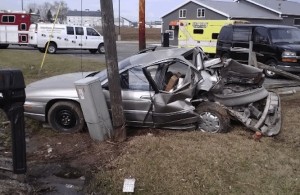
Amanda Clevinger, local mail carrier for the Harlan Post Office recently had a run in with a negligent driver. Pictured here is the aftermath, She comments, “This is my car after being hit by a distracted driver. I was stopped at a mailbox when a man who was reaching for a cigarette didn’t see me and struck me from behind.”
The post office in Sharpsburg, GA has an unfortunate twist on the U.S. Postal Service’s unofficial motto—it’s neither snow nor rain nor gloom of rear-end collision that stays these couriers from the swift completion of their appointed rounds. The postal rural carriers at the Sharpsburg post office have become easy targets for distracted drivers, following accidents this summer that have sent three people to the hospital and prompted one of their own to resign.
Anne Kerlin is a 19-year veteran and one of the six Sharpsburg carriers who has been involved in accidents over the past few years. She empathized with the most recent victims, including Jennifer Doolittle, who resigned last month. “I can understand why she quit,” Kerlin said. “I was terrified after it happened to me. You’re just waiting to get hit again. We’re just sitting ducks.” Doolittle was rear-ended in her Honda Odyssey by a 17-year-old driving a Ford F-150 near East Coweta High School.
The accident occurred near the end of the school day on Highway 154 as Doolittle was delivering mail to the last mailbox on her route. The impact spun her minivan around before it came to a stop in a ditch. The 35-year-old mother suffered head and neck trauma, minor cuts and bruising, and is undergoing physical therapy as part of her recovery. “I’m just thankful I didn’t have my hand in the mailbox, because if I had, I wouldn’t have an arm,” she said. Doolittle quit the job last month. She said lingering anxiety over the June accident, ongoing physical limitations and dealing with the red tape involved with workers’ compensation claims prompted her to resign. She had been a substitute carrier for about six years at the Sharpsburg and Senoia post offices. “That accident was enough to scare me,” Doolittle said. “I hate that road. I hate to drive.” Gina Powers was rear-ended last month by a welding company’s commercial truck on state Highway 16. Her Honda CR-V traveled 34 feet and flipped over on its top before it came to a stop, according to the police report. Powers, 42, also suffered injuries, including a broken nose.
While rural postal carriers use their own cars, which range from large trucks to compacts, many of their vehicles have been converted for mail delivery. Steering wheels have been added to the passenger side of the vehicle, passenger seats have been removed and trays have been added to hold the mail. The conversion makes for quicker and easier access to the curbside mailboxes. The rural carriers’ cars are clearly marked with official postal carrier signage, and they operate with emergency lights flashing while they are on the route.
Mail Carriers Feel They’re ‘Sitting Ducks’ for Wrecks
My wife is a cig carrier and uses the LLV. I work in the fire service. Someone should take a look at the fire service and why we are now required to have the reflective hi-visibility chevrons on the back of our firetrucks and ambulances.
The way I understand it the P.O. has to supply postal vehicles if the rural route is under a given mileage (by contract) (from retired VMF employee)
Why are Rural Carriers using own car’s? In my office all Rural Carriers are
required to use LLV’s. Many had own right hand drive vehicles and can’t use
them now. Anybody have a answer for this?
The problem Kurt is that as a rural carrier you are a contract driver… you get a set amount on money per mile that you drive and that is for gas, maintenance, signs for your car and any extra lights that you want to add… USPS doesn’t pay for anything.
That’s a genuine concern, perhaps USPS should look into the most modern efficient hazard warning lights, it would cost less than law suits.